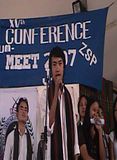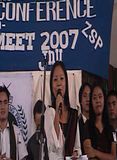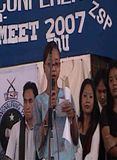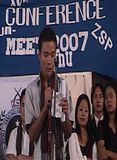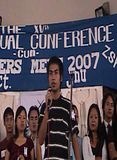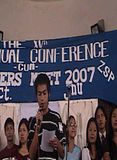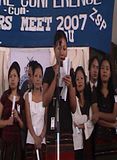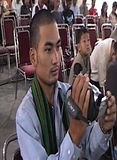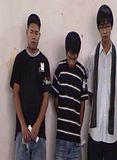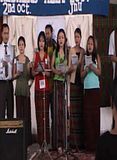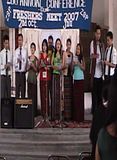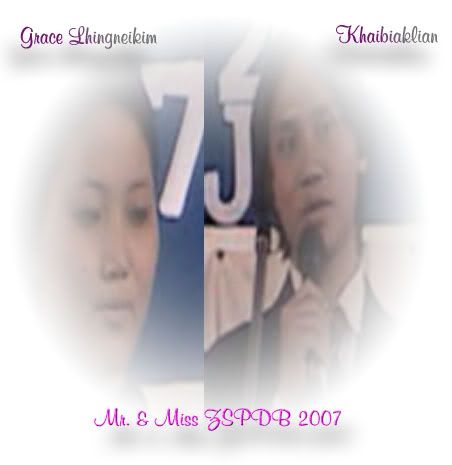By: Parratt & Arambam
I. INTRODUCTION
The manner and legality of what Menon euphemistically called the ?integration?of the Princely States into India after 1947
(1) has still not yet received the scholarly attention it deserves. Apart from the high profile cases of Hyderabad and Kashmir, and Vanja Rangaswami?s study of the southern states of Mysore, Travencore and Cochin, little in depth analysis of the fate of individual Princely States has been attempted
(2). The two north eastern states of Tripura and Manipur were among the very last to be absorbed, and Menon and his master Sardar Patel seem to have regarded them merely as a small mopping up operation. However the case of Manipur raises particularly large issues both as to the manner and the validity under international law of its absorption.
Menon?s own semi-official account reveals Patel?s and his own agenda. Specifically with regard to Manipur, which is dismissed in Menon?s account in less than page, he reveals not only a serious lack of factual knowledge about the state (which is all the more surprising given Manipur?s critical role in the events of World War II), but even more extraordinarily he fails even to get the date of merger correct
(3). His bland comment that ?the merger was signed by the Maharajah? masks - whether deliberately or through ignorance - a situation which was far more complex and controversial.
Manipuri written traditions trace its existence as an independent state back to the first century
(4). It established diplomatic relations with the British through a resident Political Agent in 1835. In 1890 a dispute over succession arose, which gave the British an opportunity to intervene in the internal affairs of the state, and the following year Manipur suffered a military defeat at their hands
(5). However the state was not annexed to the Crown, though it did lose some of its autonomy. A boy raja, Chura Chand, was appointed by the British, and the colonial power ruled through the Political Agent until he attained his majority. After Chura Chand?s coronation in 1908 the adminstration of the state was handed back to him, and he ruled with the assistance of an appointed Durbar of which the Assistant Political Agent was the President. The British retained direct control over the Hills and over the ?Reserve? in the heart of the capital Imphal. The Political Agent, acting for the Governor of Assam, had some degree of veto over the rajah?s rule, though this was seldom used (6).
II. MANIPUR?S INTERNAL POLITICS TO 15th AUGUST 1947
Towards the end of the 1930s popular movements for democratic reform began to emerge (7). Partly in response to British calls for more responsible government, but much more as a result of continual lobbying from within the state itself the Maharajah, Bodh Chandra, reluctantly agreed to the setting up of a ?Constitution Making Committee? in March 1947 (9). The Committee completed its work quite swiftly and the new constitution was adopted by royal decree in July 1947. Perhaps surprisingly, the recommendation was for elections to a Legislative Assembly by full adult franchise, with no required qualification for voting in terms either of education or land ownership (10). Due largely to the procrastination of the Maharajah elections were not held until June and July the following year. In the meantime an Interim Council was set up, largely made up of appointees of the Maharajah and Assistant Political Agent Frank Pearson, which took office the day before Indian independence was declared (11)
Manipur?s celebration of Indian independence proved a curious affair, neither the Maharajah nor the Governor of Assam, Sir Akbar Hydari, seeming to be clear as to what status it conveyed upon the relation between India and Manipur, or how the event should rightly be observed. The Manipuri leaders, whatever their views on the integration issue, seem to have taken at face value British assertions (12) that the end of British paramountcy would mean sovereign independence and the freedom for Manipur to negotiate its relationship with the new India. As it turned out the events of 15th August 1947 in Manipur bordered on the farcical, and neither of the two British officers most intimately involved, Political Agent G.P.Stewart (13) and Frank Pearson seemed particularly competent or well briefed. Stewart initially rejected the Maharajah?s proposal for a flag hoisting ceremony on 14th August, and instead requested Bodh Chandra to come to the residency at midnight, which after some demur the Maharajah agreed to do (14). Eventually Hydari tactfully indicated to the Maharajah that he would consider it a courtesy if the Union flag might be hoisted on that day along with the Manipur national flag (15) in the area of the old capital (the Kangla) situated in the Reserve (16). Stewart, taking an over zealous stand on his new (but very temporary position) as ?Dominion Agent?, vehemently rejected this idea, since in his opinion neither the Reserve nor the other former British enclaves in Manipur were to be formally retroceded to Manipur on 15th August. Eventually only the Pakhangba flag.was raised, first in the Kangla and subsequently in the Palace compound (17). Pro-Congress supporters, however, made a show of unofficially displaying the Union flag in public places in Imphal. Stewart?s brief speech expressed the wish that the agreements (the details of which he did not specify) would be carried out for the peace and prosperity of Manipur (18).
Pearson meanwhile had been desperately trying to finalise the acceptance of his nominees for the Interim Council only five days before the hand over of power, in the face of the procrastination of the Maharajah and the latter?s suspicion of the motives of his brother, Maharajkumar Priyabrata, Pearson?s proposed Chief Minister. Pearson was clearly quite naive as to the motives and qualities of the pro-Congress candidates. While his nominees were eventually pushed through, Pearson himself lost face, failed to put in an appearance at the swearing in of the Interim Council, and departed Manipur hurriedly leaving only a farewell note (19).
III. MANIPUR?S RELATIONS WITH INDIA BEFORE 15th AUGUST 1947
Manipur?s relationship to the Government of India, effected through the Governor of Assam, had been since 1891 fraught with tension and inconsistencies, and, as we have noted, the Maharajah?s rule since 1908 had been subject to certain reins of control. In this respect Indian independence left numerous loose ends to disentangle. There had been a certain degree of lassitude and case by case decisions in interpreting the various rules for the governing of Manipur (20). However that may be, on 15th August 1947 these agreements fell away. According to the Indian Independence Act (1947, paragraph 7b) on that date ?the suzerainity of His Majesty over the States lapsed and with it all treatises and agreements.? Indian independence had been announced on 10th July 1947, and on 25th of the same month Mountbatten had declared that suzerainity over the States also lapsed and they were therefore independent. Against this background it is important to examine those agreements made during this period between Manipur and the Government of India (whether or not through the Governor of Assam). Three such agreements stand out as especially important:
1. the written memoranda between the Governor of Assam and the Maharajah dated 1st and 2nd of July 1947 (21);
2. the Instrument of Accession, signed by on 11th August 1947;
3. the Merger Agreement signed on 21st September 1949.
The first two of these agreements were signed during the period of agitation leading up to responsible government, the last, of course, well after the democratically elected government had taken power in Manipur.
The memorandum of 1st July 1947, which was signed by the Maharajah and the Manipuri members of the then ruling Durbar, covered a number of heads including Manipur?s representation on the Constituent Assembly, the setting up of the Interim Council, and the need for a new constitution within one year. With specific regard to the relationship between Manipur and India the main points of agreement were:
1. that Manipur would need assistance from India ?both in external defence and internal security?; (22)
2. the Union would retain control of Posts and Telegraphs facilities, and that the arrangements regarding import and export, currency, and provincial taxation on goods would continue;
3. the Union would appoint an officer; ?to represent the Government in these matters in Manipur?;
4. ?that there would be the minimum of interference in the internal affairs of the State?;
5. that the retrocession of the British Reserve should be expedited, but that for the time being the Union Government would retain control of the cantonment, the Residency and Political Agent?s office, and the area known as Barapura (sic Babupara);
6 the matter of future rental payment for the alienated territory of the Kabaw Valley would be taken up with the Union (23)
The 2nd of July agreement (24) was also signed by the Maharajah and members of the Durbar (this time including Pearson in his capacity as President). This allowed rather more in the way of interference in Manipur?s internal affairs, including a provision that the Maharajah would accept an officer appointed by the Union Government to carry out the Governor?s functions as regards the agreement, and that this official (the Dominion Agent) could call for papers relating to the Hill tribes and issue advice, and further that no orders regarding the Hill tribes could be issued without his advice (25). However (and somewhat contradictorily) it further stipulated that ?in the application of the power vested in him under this section the Dominion Agent shall avoid interference in the day to day administration of the Hills.? Precisely what the status and practical meaning of this latter clause was is unclear, but in point of fact the Maharajah did officially assume full control over the Hills on 10th August 1947. The Legislative Assembly made provision for Hill members in proportion to the population and also for two Hill members to sit on the Council of Ministers. Whatever reservations the British and their successors might have had about the possible neglect of the Hill tracts by the goverment in Imphal thus were clearly unfounded.
Even though these agreements were signed before the elected government assumed power in Manipur, there is nothing in them which would contradict the sovereign powers of that Legislature, save in those specific areas set out in paragraphs 1 and 2 of the memo of July 1st 1947. These areas were broadly those covered by the Act of Accession, which was signed by the Maharajah on 11th August 1947. The essence of this Act is really contained in the attachment, the Schedule. This acceeded (as far as was relevent to Manipur) Union control over defence, external affairs, and communications. At the same time it explicitly guaranteed to the ruler his continued sovereignty over the State (26)
IV. CONTINUING INDIAN-MANIPUR RELATIONS AFTER 15th AUGUST 1947
On the day of India?s independence there were demonstrations in Imphal, organised largely by left wing groups, agitating for the replacement of the pro-Congress Interim Council by an elected Assembly. These were well attended but were also marked by a certain amount of pro-Union activity, including the waving of Indian flags. As we have seen, largely due to the procrastination of Bodh Chandra and the desire of the Interim Council to hang on to power, the elections for the Legislature were not held until June and July 1948.
The results of these elections were inconclusive, and a coalition government took office made up of the majority the Praja Santi (a broad pro-royalist party), supported by the Peasant Party (the Krishak Sabha), and the Hill members (27). The expectations of the Manipur State Congress that it would control the state were disappointed. As the second largest party the Manipur State Congress became the official opposition, and this was to have repercussions in their attempts to seize power with the support of the All India Congress later on. However the new Legislature was not scheduled to take office until 18th October 1948, and in the meantime the pro-Congress Interim Council continued to hold power, and did what it could to disadvantage its opponents (28).
Stewart left Manipur on 17th August, and his place as Dominion Agent was taken by Debeswar Sharma. Sharma did not arrive until the November and seems to have been a quite disastrous choice. The Manipuri leaders regarded him as too smooth to be trusted, and it was not long before he was plunged headlong into a baptism of fire which cruelly exposed his deviousness and inadequacies (29). The Congress in Manipur had been rent into two factions for some time, and both were dominated by men whose main aim seem to have been to seize political power and all its material benefits. Boycotts and strikes became commonplace, and were often hijacked by one or other Congress group for their own ends. Sharma was drawn into the mire of local politicking with disastrous consequences for his official position. He was dismissed by Hydari in May 1948 (30). The Governor decided that he would henceforth deal directly with Manipur himself, and went on to appoint MK. Priyabrata, who was still Chief Minister, to act on his behalf with the title of ?Dewan.? (31). The confusion of these two roles, with their different responsibilities, in the same person was to have unhelpful repercussions later on.
Sir Akbar Hydari died on a visit to Manipur in December 1948 (32). He was succeeded by Sri Prakasa, a very different character and a career diplomat with a very clear agenda for the swift and ruthless integration of the north eastern states of Manipur and Tripura. Fortuitously, and as it turned out unhappily for Manipur, Prakasa had already met Bodh Chandra some years before. In 1934, during the reign of his father Chura Chand, Bodh Chandra had been sent out of the state to Banares into virtual exile because his father had suspected he had been implicated in a plot to seize the throne. There he had been befriended by Prakasa, and lived with him for three years (33). Whatever the exact relationship between the two, Bodh Chandra clearly felt obligated to Prakasa on a personal level and this seems to have clouded his judgement with regard to state affairs. Prakasa, for his part, lost no time in preparing the ground for a takeover of Manipur. He visited Manipur in March 1949. In a meeting with Bodh Chandra he continued to give the Maharajah the impression that the Union Government had no designs on the state, and later put in writing that the ?distinct identity of Manipur would be preserved, and that no merger with the Centre or any other territory would be effected, except military relations for the defence of India as a whole? (34). This last comment was ominous (though no one in Manipur realised this at the time), and the following month Prakasa sent his military advisor with Rustomji (the special advisor for the northern states) to assess the suspected Communist threat (35). Despite the evident public concern that these visits were harbingers of an Indian takeover, the Legislative Assembly failed to debate the darkening political situation. The Maharajah meanwhile began to realise that, since Prakasa intended to appoint a new dewan in place of Priyabrata, he would be well advised to clarify this official?s role and authority. In a long memorandum to the Governor (36) he stipulated that if a dewan were appointed it should be a person acceptable to the Maharajah himself, that he should have the power to demand the dewan?s removal, and that the dewan should ?have the minimum of interference in the administration of the state? and function only to safeguard the treaty obligations between Manipur and the Union. Bodh Chandra?s memorandum was rudely ignored, and Prakasa proceeded to reinvent unilaterally the powers of the dewan. On 14th April 1949 Rustomji came back to Imphal with the new dewan, Major-General Rawal Amar Singh (37). Rustomji brought with him a letter setting out the powers which the Government of India had given to the dewan over the State of Manipur (38). These were severe and wide ranging. Crucially the Indian Government demanded that ?the administration of Manipur State would be carried on under the general superintendence, guidance and control of the Dewan?, who would have the right to call for any papers from any ministry and ?pass such orders as he might consider fit and proper on them, in consultation with the Minister concrned.? The Dewan would further have direct charge of the portfolios of Law and Order, Administration of the Hills, State Forces, and Relations with the Government of India, and would also have the ultimate say in the distribution of portfolios (such as remained!) within the Council of Ministers (39). Nothing in previous agreements waranted such sweeping powers for the representative of the Government of India, and these demands were thus without any legal basis. Prakasa, however, continued to feed the gullibility of the Maharajah with the myth that nothing in these requirements affected the dignity of the State. Rustomji demanded the Maharajah issue an order accepting the appointment of Rawal Singh and the conditions of his appointment within two days. No discussion was permitted, and Bodh Chandra weakly caved in to pressure (40). Neither the Council of Ministers or the Legislature questioned the sweeping powers given to the Dewan over the State, nor whether, since the Maharajah?s authority had now passed to the elected Legislature, he actually had the power to make the proclamation appointing a dewan with such vastly enhanced powers. The way towards annexation had now been smoothed by a skilful combination of deviousness and bullying on Prakasa?s part. The weakness of the Maharajah?s response, and the lamentable failure to grasp political realities on the part of the Legislature, had made a takeover virtually certain.
Bodh Chandra subsequently began to have second thoughts. Two months later he wrote to Prakasa and belatedly pointed out that there was no provision in the State Constitution for a Dewan with these powers and that it was in any case up to the Assembly to approve the regulations (41). Unsurprisingly Prakasa cursorily dismissed this protest with the comment that the Government of India did not recognise the Council of Ministers or the Assembly, and regarded the Maharajah as the sole ruler of the State. To add insult to injury he went on to instruct the Maharajah to make full use of the advice of the Dewan, with a veiled threat of the consequences if he did not (42). This was indeed a cynical response: the Government of independent India, which proclaimed democracy as a major plank in its platform, was now declaring itself unwilling to recognise the democratically elected government of a state on its borders.
Meantime, as news of these events became public, reactions became polarised. The Socialist parties submitted a formal protest at the Dewan?s assumption of powers which constitutionally belonged to the Legislature, but since their own agenda was for the merger of Manipur with other territories in Assam they secured little popular support. An attempt by the Manipur State Congress (which was by now largely in the pocket of the All-India Congress) to drum up support for full merger with India at a mass public meeting backfired badly when most of the crowd decamped to another venue. There they passed strong resolutions denouncing the Manipur Congress? ?deceitfulness?, and insisting that the kingship must not be abolished nor the state be integrated into India (43). The Hill MLAs convened and declared themselves firmly against any merger proposal, as did the Muslim members (44). The Communists predictably denounced the Nehru government as inefficient and lackeys of the West. In August the MLAs belonging to the ruling coalition Praja Santi party, which favoured a separate state, authorised N. Ibomcha (a Meitei) and Lunneh (a Hill Member) to prepare a paper setting out coherent reasons why Manipur should not be merged with India. Copies of this paper were sent to the Prime Minister Nehru, to Deputy Prime Minister Sardar Patel (who was also of course also in charge of the States), to the Governor of Assam, and to the Dewan. (45). But by this time of course the Government of India had long since determined on its course of action. Their plea fell on deaf ears and no opportunity was afforded the members to put their case orally (46). The stage had been set for the final act.
V. ?IS THERE NO BRIGADIER IN SHILLONG??
The main players on the Indian side, Rawal Amar Singh and Prakasa realised that the simplest way to attain their objective was to isolate the weak Maharajah from his advisors and the Council of Ministers, and subject him to pressure. Meanwhile Rustomji, aware of the antagonism between Bodh Chandra and his brother Priyabrata, who still retained his position as Chief Minister, continued to cultivate the latter?s confidence (47). . Events conspired to lead Bodh Chandra to play into their hands.
Bodh Chandra was by now becoming more and more irritated at the Dewan?s frequent and often tactless interference in the affairs of the state. This came to head in a sharp conflict over an issue concerning the legality of the election of a Muslim member to the Legislature. The Maharajah determined to address his complaint about the Dewan directly to the Governor, and on 29th August sent a telegram to Shillong asking for a meeting with Prakasa. In early September Prakasa, together with Rustomji, went to Delhi to meet Menon, who instructed the Governor to expedite the merger of Manipur. From there they were summoned to Bombay to receive further orders from Sardar Patel, who was by then seriously ill. When Prakasa ventured to suggest that the Maharajah might not agree to sign the merger document, Patel?s reply left him in doubt as to the course of action he would need to take in such an eventuality: was there, he demanded, no brigadier in Shillong? (48). On his return Prakasa invited the Maharajah to discuss the situation in Manipur. Bodh Chandra was later to claim that he did not suspect that a proposal for a full merger with India would be on the agenda at this meeting. If this is so then it would indicate that the Maharajah was totally out of touch with events, for by early September the press both within and outside the state had been speculating about the matter. The speaker of the Assembly had also unsuccessfully requested that the issue of a possible merger should be debated in the House. At any rate Bodh Chandra, together with his advisors, servants, and an escort departed from Imphal in a fleet of cars on 15th September, and reached Redlands, his personal residence in Shillong, on 17th. He immediately sent his ADC to the Governor?s residence to advise Prakasa of his arrival, only to be told that the latter was away from Shillong. (49). Meanwhile Redlands was surrounded by a strong contingent of the Indian army, who pitched their tents within the grounds. Plain clothes police also appeared and refused to allow anyone in or out. Attempts by the Maharajah?s staff to send out telegrams were refused, and since there was no telephone in the building the Maharajah?s party found themselves virtual prisoners. Requests to withdraw the security police were ignored (50).
Prakasa arrived back late in the evening and it was arranged that he would meet Bodh Chandra at 9 a.m. on the 18th. The Maharajah?s party, consisting of Bodh Chandra himself, his ADC Mayengbam Anandamohon, and his private secretary, Sanasam Gourahari, arrived shortly before the appointed hour but were then kept waiting for some time. Prakasa eventually appeared, and with him Rustomji and the secretary, Krishnamurthy. The latter now presented the merger document to the Maharajah, who read it through and commented that he could not sign it without first consulting his Council of Ministers. This position he maintained despite crude threats from Rustomji (51). Prakasa?s approach, perhaps because he knew Bodh Chandra, was more diplomatic. However he argued that he was under orders from Menon, and could not accept the Maharajah?s proposal to return to Imphal and consult his ministers. He stressed that the merger had to be signed within ?a few days.? A further meeting was agreed for the following morning.
According to Gourahari, Bodh Chandra was so deeply upset that he wept profusely on the way back to Redlands, and Gourhari feared that he would ?behave insanely? (52). Prakasa continued to pressurise Bodh Chandra by sending him a written message to the effect that he had now been instructed that the merger had to be signed by the 30th. The Maharajah, by now composed, again responded that it would be unconstitutional for him to sign the merger, since sovereignty in Manipur had been transferred to the elected Assembly (53). Prakasa immediately cabled Patel that since the Maharajah was intending to return to Imphal for consultation he had instructed the police to detain him and his party if they attempted to leave Redlands. He requested the Deputy Prime Minister immediately to telegraph instructions for Bodh Chandra?s detention under any orders whatsoever (54). Both the police and army guards on Redlands were doubled (55).
Next morning, September 19th, Bodh Chandra wrote to the Governor cancelling their appointment since in his view it would serve no purpose. A brisk exchange of notes continued throughout the day. Prakasa repeated that it was the Government of India?s intention to deal only with the Maharajah as the sole ruler of the state, and then promised that the Government would take responsibility for any objections which might be raised within Manipur (though quite how they intended to do this was not specified). Bodh Chandra was mollified to some extent, but still not convinced, and repeated his view that under the Manipur constitution only the Council of Ministers could decide on the merger. He agreed to meet the Governor again and read, and even commented on the draft agreement (succeeding in the process in securing a substantial increase in his own privy purse) but continued to maintain that he could not sign the document alone.
Prakasa now decided on a more intimate approach, and sent a message to say that he would come unaccompanied to Redlands that afternoon. He arrived one hour early, while the Maharajah was taking a siesta. When he emerged, only half dressed. Prakasa spoke to him ?as a son? and told him that the Indian Government was quite prepared to use force. He went on to say that if this were about to happen he would have to resign as Governor of Assam, and his replacement would be likely to impose much harsher conditions on Manipur. Bodh Chandra gave in and agreed to sign that day. His ADC, Gourahari, had been confined to his room under guard while this conversation was going on. When he remonstrated with his ruler Bodh Chandra responded that they would try the merger for a few years, apparently under the impression that it could be reversed (56). The final version of the agreement contained no indication of the way the state would be governed. Its main provisions concerned the Maharajah?s Privy Purse, and the privileges he would retain, and the conditions of service for public servants (57). Back in Manipur rumours about the signing began to circulate (including one that the Maharajah had been forced to sign at gun point). Though there was much talk, there was little action. No voice was raised in the Assembly, and the honorable members occupied their final days discussing the matter of liquour tax. Most MLAs seemed intent on preserving their privileged positions under the new regime, but in this almost all of them were to be disappointed. The focus of opposition now shifted to the underground armed resistance movements.
The handover ceremony took place on 15th October on the polo ground in a heavy rainstorm. The Governor of Assam was not present and attendance was sparse. Many of the Manipuri leaders (including MK. Priyabarta) stayed away. The same day Rawal Amar Singh became the first Indian Chief Commissioner of Manipur. His first act was to issue an order abolishing the Council of Ministers and the assembly, and appropriating all powers in his own hands. A few days earlier a battalion of the regular Indian army had been stationed in Imphal to discourage any possible riots against the merger and to neutralise the contingent of the Assam Rifles, whose loyalty to India was considered doubtful. Along with integration into the Indian Union an era of heavy military presence had begun.
VI. CONCLUSION
Half a century on, Manipuri politicians and historians (in common with those elsewhere in the north east) have begun to reexamine the circumstances and implications of absorption into the Indian Union. A number of the factors which, at the time, were advanced to justify the takeover of Manipur, now look increasingly unconvincing. Sardar Patel?s theory of a common Aryan blood as a uniting bond for the Indian sub-continent simply does not apply in much of the north-east, which is ethnically, linguistically, and culturally quite distinct. The supposed Communist threat in Manipur was grossly (and possibly deliberately) exaggerated, and the other insurgency movements were in the main a direct result of Indian annexation. The claim by the Union Government that Manipur suffered from underdevelopment was probably true, though most Manipuris would argue that since 1949 it has remained neglected and grossly underfunded, with much of its resources being used to fund the wholly counterproductive presence of Indian security forces.
But more important has been the questioning on the part of Manipuri intellectuals of the whole legality of the merger. Aside from the now largely discredited remnants of the old Manipur Congress, most would argue that on 15th August 1947 full independence returned to Manipur.(58). The State Constitution, adopted the previous month and brought to fruition with the convening of the Legislative Assembly in the October of the following year, was the first in the sub-continent to grant full adult franchise, with the Maharajah as a constitutional sovereign (59). The bitter irony, as Manipuris see it, is that independent India, which proclaimed its dedication to democracy, wilfully refused to recognise the democratically elected government of its tiny neighbour, and instead persisted in dealing with the former feudal ruler, who himself repeatedly protested that he had surrendered his power to the elected Assembly. Furthermore, Manipur was not a petty state surrounded by Indian territory, but a border state more akin to Sikkim and Kashmir. It is difficult to deny the force of these arguments, and to resist the conclusion that the Union Government, in its eagerness to maximise its borders, simply annexed Manipur.
There would, of course, have been severe practical difficulties in the way of Manipur?s preserving its independence. The Union Government controlled most of its finances and indeed froze all the State funds held by the Treasury. Furthermore, Menon?s interpretation of the defence clause in the Standstill Agreement and the Act of Accession would have enabled Indian troops to enter the state, not only on the grounds of external threat, but also whenever internal security appeared to be threatened (60), and one can well imagine that pretexts for such action would not have been hard to create. The inaction of the United Nations, which disapproved of the invasion of Hyderabad in 1948 and of Goa thirteen years later, gives no grounds for thinking that Manipur would have had practical support from the international community at the time. In the end, as Priyabrata asks (61), to which court could Manipur have appealed? All that could have been done, he concludes, was ?to act like Mr Phizo? (62).
NOTES
1. V.P.Menon Integration of the Indian States (Madras 1956): references below are to the 1996 edition
2. see Rangaswami The Story of Integration, a new interpretation (Madras 1981);Ian Copland?s revisionist The Princes of India in the Endgame of Empire 1917-1947, (Cambridge 1997) unfortunately contains only three minor references to Manipur, all of them to one degree or another inaccurate. There are no indexed references to Manipur in T.P. Mansergh?s The Transfer of Power. Apart from Kashmir, Manipur was in the last group of states to be integrated (along with Tripura, Bhopal and Cooch Behar).
3. Menon gives it as 15th October 1948, which a full year too early: Menon op cit p. 302.
4. Cheitharol Kumbaba (Royal Chronicle) edited by L. Ibungohal Singh and N. Khelachandra Singh (Imphal 1987). While the first sections of the Chronicle are cast in mythological language it is substantially historically correct from about the 14th century.
Apart from a brief period of Burmese domination between 1819-1825 Manipur functioned as an independent monarchy.
5. see John Parratt & Saroj Arambam Parratt Queen Empress vs. Tikendrajit: the Anglo-Manipur conflict of 1891 (New Delhi 1992).
6. for the situation during this period see J. Shakespear Manipur under British Management 1891-1907 (Shillong 1907) and Lal Dena British Policy towards Manipur 1891-1919 (Imphal 1984).
7. See Saroj N. Arambam Parratt and John Parratt ?The Second Women?s War and the emergence of democratic government in Manipur? forthcoming in Modern Asian Studies. For general surveys of this period see especially Karam Manimohan Singh Hijam Irabot Singh and Political Movements in Manipur (New Delhi 1989) and N. Lokendra Singh The Unquiet Valley: society, economy and politics in Manipur 1891-1950 (New Delhi 1998).
8. Bodh Chandra had successded his father Chura Chand in 1941. The first formal demand for a democratic constitution was made by the Nikhil Manipuri Mahasabha in 1938, though the socialist reformer Hijam Irabot had made public calls for reform earlier than this. See John Parratt and Saroj N. Arambam Parratt ?Hijam Irabot and the radical socialist democratic movement in Manipur? forthcoming in Internationales Asienforum.
9. This committee was composed partly of members nominated by the Maharajah and partly by election with limited franchise. Most of the nominated members were strong Manipur Congress supporters; the Durbar President, Frank Pearson, who made no secret of his support of Indian Congress and opposition to full franchise, was largely responsible for securing their appointment.
10. The constitution provided for the appointment of a Council of Ministers from the members of the Legislature, but the appointment of the Chief Minister remained in the gift of the Maharajah. This was the first election on the basis of full adult franchise on the Indian subcontinent, the rest of India had to wait until 1952.
11. Maharajkumar Priyabrata, the brother of the Maharajah, replaced Pearson as Chief Minister.
12. Menon himself gives some of the relevent statements by Attlee and Mountbatten (op cit p 476) and also by Nehru and Patel (p 276): though of course it is clear that neither Nehru or Patel was inclined to consider full independence of any state as a realistic option.
13. who actually knew Manipur quite well, having served as Durbar President in the reign of Chura Chand.
14. Lt.-Col. H. Bhuban Singh has a highly amusing account of this meeting based on eyewitness reports, see his The Merger of Manipur (Imphal 1988) pp. 71-74.
15. known as the Pakhangba flag, it consisted of an intricately coiled snake symbol, representing Pakhangba, the ancestral deity of the Meiteis.
16. This area, the Kangla, was the former palace compound, which was seized by the British in 1891
17. Bhuban, whose synpathies were for Indian integration, maintains both flags were raised (op cit p. 74), but the official programme, quoted by Karam Manimohan (op cit. p. 250), and eye witness accounts, do not support this. The raising of the Pakhngba flag in the Kangla can only be regarded as a statement that full sovereignty had returned to ?Meiteileipak? (Manipur). This is confirmed by the entry in the Cheitharol Kumbaba for Friday 29th of the month Thawan (June/July), which states that ?at ten minutes past ten o?clock the maharajah and the maharani sat in the Kangla and performed a religious rite, saying that from that day onwards they had possessed the country. At ten forty a flag with the insignia of Pakhangba was flown in the state durbar in the Kangla. At eight o?clock in the presence of all the people the bara sahib, in the state durbar hall, handed over all the land of Manipur into the hands of Srijut Maraharajah. Asongshangbam Major fired an eighteen canon salute.?
18. Karam Manimohan op cit 251.
19. Pearson?s memoir confirms Manipuri reports of him as politically clumsy and naive, and clearly taken in by the Congress leaders (British Library, Oriental and India Office Collections (hereafter O&IOC) MS EUR F226/21). Most other sources, English as well as Manipuri, regard the Manipur Congress leaders as unprincipled power seekers. I can find no supporting evidence for Pearson?s claim that Congress wanted him to stay on as Chief Minister, though this is not unlikely as they were obviously cleverly manipulating him for their own ends: as it turned out the Congress Party failed to dominate the Legislature.
20. The last British orders regarding the administration of Manipur were promulgated in 1935: during the Second World War Manipur was under military rule.
21. Manipur State Archives (hereafter MSA) Secret file C July 1947: the full texts are also given by Karam Manimohan op cit. p 223-4.
22. though the interpretation put on the latter phrase by Patel and Menon went far beyond what the Manipuris understood by it.
23. The Kabaw Valley, situated between
Manipur and the Chindwin River, was in Manipuri possession until it was occupied by the Burmese during the first Burmese war. It was subsequently recaptured by Maharajah Gumbhir Singh in 1824-5. At the Treaty of Yandaboo the British agreed to allow the Burmese to occupy it for in exchange for an annual rental fee payable to the Maharajah.
24. This was actually a revision of an earlier draft which had been rejected a few days before
25. This clause was presumably in deference to the fact that after 1891 the British had assumed direct control over the hills: this provision in fact limited the democratic representation of the hill peoples in contrast to the Manipur constitution.
26. ?Nothing in this Instrument affects the continuance of my sovereignty in and over this State, or, save as provided under this Instrument, the exercise of any powers, authority and rights now enjoyed by me as Ruler of this State or the validity of any law at present in force in this State? (paragraph 8).
27. Besides the local constituencies, both Valley and Hill, there was provision for additional elected members representing commerce, education and the Manipuri Muslims.
28. The biggest casualty was Hijam Irabot, the leader of the socialist and peasant movements, who was forced to go underground: on Hijam Irabot see John Parratt and Saroj Arambam Parratt ?Hijam Irabot and the radical socialist-democratic movement in Manipur? in Internationales Asienforum (forthcoming).
29. Nari Rustomji, in his memoir Enchanted Frontier (Calcutta 1973) p. 89 described him as ?a senior Congressman of great ability and high ambitions.? E.T.D. Lambert?s ?Special Report on Manipur? of 14.9.48, had a rather different view: of the man: he was, wrote Lambert, ?one of the nastiest pieces of work in Assam, a high grade opium smuggler and smooth individual with the tongue of a rattlesnake and the mind of a corkscrew? (O&IOL L/P&S/13/1803, Pol 4508/48).
30. according to Lambert for issuing over 500 illegal gun licenses and racketeering in the issue of petrol coupons; but, as important, he clearly failed to exercise any diplomatic skills as Dominion Agent
31. despite the fact that relations between Bodh Chandra and his brother Priyabrata were cool, and that the Maharajah had tried to avoid appointing him as Chief Minister.
32. Hydari seems to have had a genuine concern for the state and related well to Bodh Chandra. He frequently visited Manipur for duck shooting at Lake Loktak, and it was there that he died. He was buried in Manipur. The course of the merger may well have been different had he lived.
33. MK. Priyabrata ?Reminisciences of the First and Last Chief Minister? in Naorem Sanajoaba ed. Manipur Past and Present vol 1 (New Delhi 1988) p. 139; Bhuban op cit. pp 115-6; also personal communication (1980) from the late Songaijam Nabakumar, a member of the Maharajah?s staff..
34. MSA file DO 1986 P II/1 dated 23.3.49.
35. The Communist threat was greatly overplayed for their own political advantage by all parties at the time - the British, the Union Government, and the Manipur Congress, and also by the Interim Government: despite the connection of Hijam Irabot with Burmese Communist groups, the possibility of a Marxist takeover of Manipur was never remotely likely.
36. MSA file DO No 2088 P II/1 no date.
37. Bhuban op cit. 123 points out that his credentials were suspect in that his rank was not earned in the Indian army, but in the service of the state of Jaipur, and that mainly for ceremonial duties.
38. quoted in full by Karam Manomihan op cit. pp. 334-5.
39. MSA correspondence of Prakasa to Bodh Chandra 14.4.49.
40. MSA Order 138 of 16.4.49 by Maharajah Bodh Chandra
41. MSA correspondence of Maharajah Bodh Chandra to Governor of Assam 25.6.49.
42. MSA correspondence of Prakasa to Bodh Chandra 4.7.49.
43. Karam Manimohan op cit. 347-8, also N. Joykumar Singh Merger of Manipur with India in Lal Dena ed. The History of Modern Manipu (New Delhi 1991) p. 184.
44. Lokendra op cit. p. 227.
45. MSA Resolution of the meeting of MLAs of the Praja Santi Party held on 25.8.49; also Karam Manimohan op cit. 352, Lokendra op cit. 226.
46. We cannot trace responses from any of the addresees to the Praja Santi?s paper.
47. Priyobrata was an educated and calable man, and a former captain in the Indian army: his sympathies however leaned towards merger with India. He had got to know Rustomji while in Shillong immediately after the war.
48. Rustomji op cit p. 109. Rustomji goes on to claim that he subsequently went to Imphal and told the Maharajah of the imminence of the enforced merger. We can find no confirmation of this in any of the Indian or Manipuri records, and such a claim can hardly be reconciled with what happened in Shillong.
49. Rustomji?s claim (op cit. 109) that he and Prakasa ?met the Maharajah on his arrival? cannot be correct.
50. The details of events at Redlands
are given in Bhuban?s book, which is based on eyewitness accounts, including those of Gourahari and Anandamohan, both of whom were with the Maharajah during the negotiations. Bhuban himself is by no means antagonistic to the merger, which supports the essential trustworthiness of his account.
51. Bhuban (op cit. p.106) reports that Rustomji threatened that if Bodh Chandra did not sign he would never leave Shillong. At this the Maharajah turned to Prakasa and said he had not come there to talk to Rustomji but to the Governor. Prakasa then silenced his assistant.
52. Bhuban op cit. 108: according to Gourhari?s account Bodh Chandra?s ?insanity?manifested itself
again around midnight, when he proposed that he and his ADC should assassinate the Governor and then kill each other: this is supported by Songaijam Nabakumar (personal communication 1980).
53. Bhuban quotes the text of the note in full p. 109).
54. source Bhuban: the urgency was stressed, ?immediately repeat immediately.?
55. Rustomji op cit. p. 109 euphemistically speaks of the Maharajah being ?honoured by a ?protective? guard.?
56. Bizarre though the attitude of the Maharajah appears, there is clear evidence that the draft as signed by Bodh Chandra included several provisions which were omitted from the final version, including a clause which could be so interpreted. Article VI originally contained the provision ?it is also to be distinctly understood that should any circumstance hereafter arise by which the administration of the State now made over to the Dominion Government is to be reverted, then it should be restored to the Maharajah or his successors along with Manipur?s original rights.? Additional clauses which do not appear in the final version included those safeguarding the priority of Manipuris for employment within the state, restricting immigration from outside Manipur, and continued Manipuri control of imports and exports (Article X): all these provisions were disregarded after October 1949. For the full texts of the sections omitted from the final version of the merger document see Karam Manomohan op cit. pp 428-9).
57. The last was violated almost immediately with the influx of appointees from India over the heads of existing Manipuri civil servants.
58. The best collection of papers making a strong defence of this case is the symposium Annexation of Manipur published by the People?s Democratic Movement (Imphal 1995) being papers delivered mainly by academics and politicians two years earlier. The keynote address by Professor Noarem Sanajoaba, ?Manipurgi Lousinkhibagi Wathokta Achumba Khiba? (The Problem of the 1949 Annexation) (pp. 54-66) presents a trenchant analysis the issue from the standpoint of international law.
59. While it is true, as RK Jhlajit Singh points out in his strongly pro-Congress account in A Short History of Manipur (2nd edit. Imphal 1992) p. 336-7 that there were some shortcomings in the constitution, especially in the prerogative it gave to the Maharajah to nominate the Chief Minister, his characterisation of it as ?a dangerous anachronism? is quite wrong: on the contrary it marked for the first time a break from a feudal monarchy.
60. Menon op cit. pp. 97, 112
61. op cit 128.
62. which is what some did, though
without a great deal of success: on the ?insurgency movements? see especially Phanjoubam Tarapot Insurgency Movement in North Eastern India (New Delhi 1993).
Source: http://www.kanglaonline.com/index.php?template=kshow&kid=4&Idoc_Session=81a9c7ea1a20d44eea9e70346abfef5a




